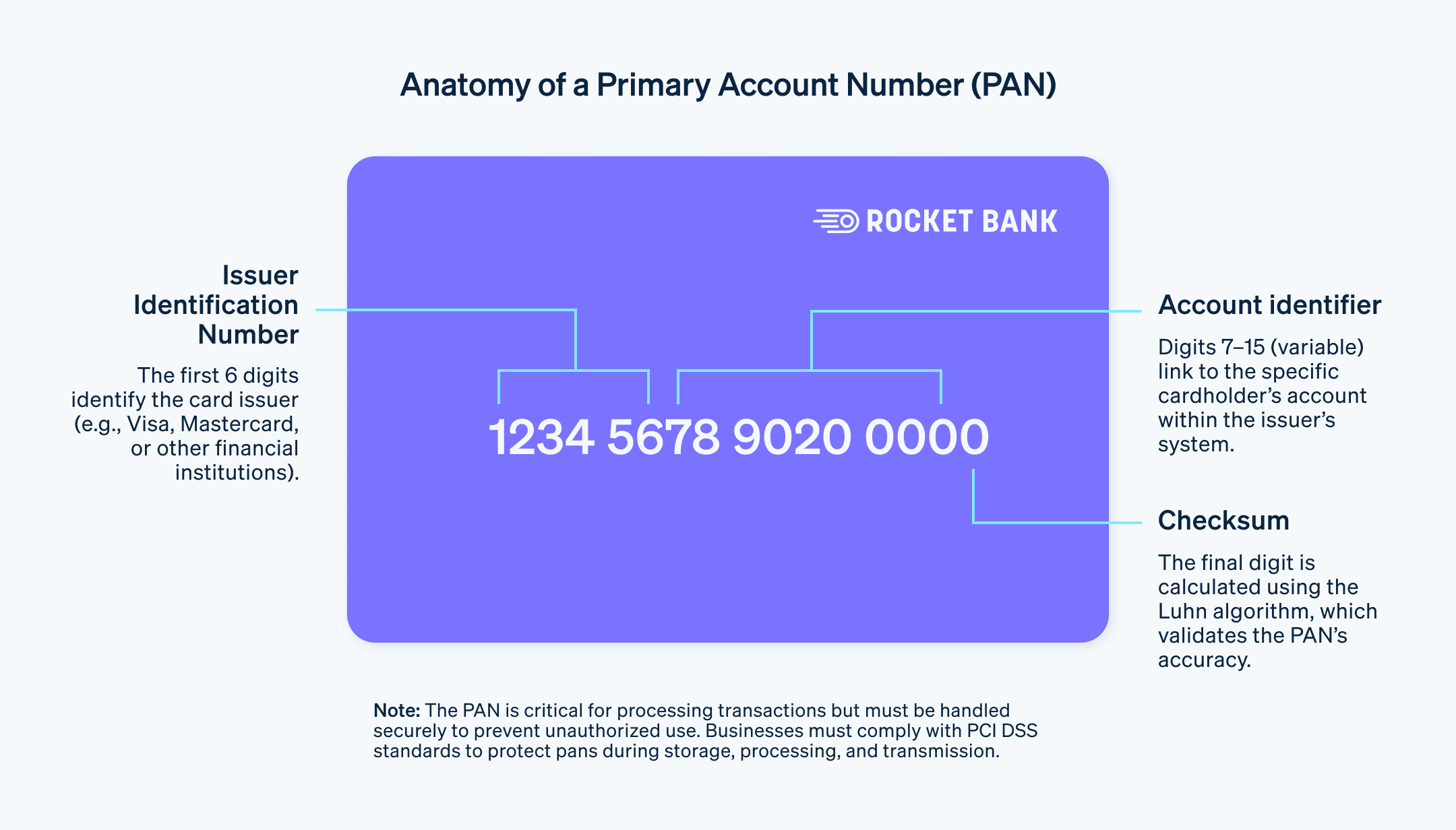金融生活中变化最大的方面莫过于我们进行支付交易 的方式。企业,尤其是那些处理银行卡支付 的企业,处于这一转型的最前沿,必须处理支付处理 的核心数据,包括主账号 (PAN)。
对于企业而言,安全高效地使用 PAN 并非易事,而是企业运营的核心环节,可直接影响企业的声誉和客户信任度。为了维护稳健且合规的支付系统,企业必须了解与 PAN 有关的监管环境、安全措施和实际考虑因素。这些知识可能看起来过于细化,对企业来说毫无意义,但随着支付系统和欺诈预防工作变得更加复杂和广泛,了解支付基础知识将成为任何进行银行卡交易 的企业的基本要求。
下面,我们将探讨 PAN 的功能、PAN 与其他账号之间的重要区别、管理 PAN 的标准以及企业为保护和改进其使用可以实施的最佳实践。
目录
- 什么是主账号 (PAN)?
- 主账号如何运作
- 主账号与账号
什么是主账号 (PAN)?
主账号 (PAN) 是支付卡号的技术术语,是信用卡、借记卡或预付卡上压印或编码的一串数字(通常为 12 到 19),用于识别发卡机构 和特定账户。PAN 由金融机构分配给持卡人账户,是促进参与处理付款的实体之间通信的关键数据。确保 PAN 安全非常重要,因为滥用或未经授权的访问会导致欺诈性交易 或身份盗窃。

主账号如何运作
了解主账号的作用对于支付处理 行业中的任何人都很重要。此唯一标识符位于支付交易 的核心,将持卡人关联到存储在发卡机构数据库中的账户信息。
以下步骤显示了 PAN 在银行卡支付交易中的角色:
1.交易发起
当持卡人发起交易时,支付终端通过磁条、EMV 芯片 或近场通信 (NFC)(适用于感应式支付)从银行卡读取 PAN。
2.令牌化
令牌化 增强了交易安全性,尤其是在数字或无卡 (CNP) 环境中。此过程将 PAN 替换为每笔交易的唯一令牌,从而在交易数据泄露的情况下保护真实账户详细信息。
3.数据传输
交易信息(包括 PAN、交易金额和企业信息)被加密并发送到企业的银行(也称为收单行或收单机构)。
4.转发信息
然后,收单行通过卡组织 将该信息发送到持卡人的银行(称为发卡行或发卡机构)。
5.验证检查
发卡行使用 PAN 查找持卡人的账户,并在批准交易之前检查账户余额、银行卡有效性和任何潜在的欺诈迹象。
6.交易审批
发卡行批准交易后,响应就会通过卡组织 发送到收单行,并最终发送到企业的终端,通常在几秒钟内完成。
PAN 在支付处理中发挥着重要作用,企业必须认真对待与 PAN 相关的安全性。支付卡行业数据安全标准 (PCI DSS) 等安全标准有助于在存储、处理和传输过程中保护 PAN。这些措施包括:
加密
此过程将 PAN 数据转换为编码形式,使没有解密密钥的任何人都无法读取。PAN 在从交易点(例如支付终端)到相应金融机构的传输过程中是加密的。加密可确保即使诈骗分子拦截了交易数据,他们也无法理解或使用它。截断
截断是指在显示 PAN 时移除 PAN 的一部分。例如,在收据或付款确认屏幕上,您可能只看到 PAN 的最后四位数字,其余数字替换为 X 或星号。截断有助于保护 PAN,确保完整号码不会显示在诈骗分子可以看到和复制它的地方。遮蔽
与截断类似,遮蔽涉及隐藏 PAN 的一部分,通常是在持卡人输入号码或屏幕上显示号码时。例如,当您在网站上输入卡号时,通常会在您输入后立即看到每个数字都被星号替换。这样可以确保无论是偷窥者还是恶意屏幕捕捉软件都无法读取完整的 PAN。
这些措施有助于与客户建立信任,因为它们表明企业认真对待其支付信息的安全性。处理银行卡支付的企业必须遵守这些标准,否则可能会受到处罚。
主账号与账号
主账号和账号都是金融账户的唯一标识符,但它们具有不同的用途和应用,尤其是在支付处理 上下文中。以下是它们之间主要区别的概要:
主账号
PAN 是信用卡、借记卡或预付卡上显示的 12 到 19 位数字。它是由发卡银行或金融机构发放的标识符。PAN 标识持卡人的账户,还包含有关发卡行和卡类型的信息。
PAN 用于销售点 (POS) 终端 的刷卡交易以及线上付款。由于 PAN 具有敏感性,可在处理支付的相关实体之间进行通信,因此企业必须以高度安全的方式处理这一关键数据。PCI DSS 等标准规定了企业在存储、处理和传输过程中应如何保护 PAN。
账号
账号是在银行或其他金融机构持有的账户的唯一标识符。与 PAN 不同,账号不包含有关发卡机构或卡类型的信息。相反,它直接关联到个人或企业的账户,主要用于与银行的直接交易,例如存款、取款或转账。
通常,账号用于直接借记、电汇 以及其他形式的直接银行转账。您可以在银行对账单上找到账号,也可以通过银行的在线门户或客户服务渠道获取。尽管安全地处理账号也很重要,但账号不受与 PAN 相同的严格 PCI DSS 标准的约束,因为它们不用于银行卡交易。
虽然 PAN 和账号都用作唯一标识符,但它们的应用有所不同。处理银行卡支付的企业需要了解有关 PAN 的监管要求并保护这些数据。虽然账号在直接银行交易中更为常见,但参与此类活动的企业也应确保安全地处理这些号码。
银行卡支付的细节(例如 PAN)可能看起来是次要问题,对企业来说并不重要。但是,随着技术改变银行卡支付的处理方式,了解银行卡交易的详细组成部分可以使企业在采用和改进支付技术的使用方面占据优势。
本文中的内容仅供一般信息和教育目的,不应被解释为法律或税务建议。Stripe 不保证或担保文章中信息的准确性、完整性、充分性或时效性。您应该寻求在您的司法管辖区获得执业许可的合格律师或会计师的建议,以就您的特定情况提供建议。